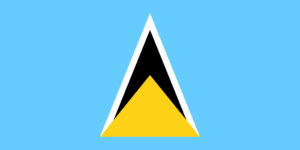History of Saint Lucia:
Saint Lucia is an island nation in the Caribbean Sea. The island is considered part of the Windward Islands, and its name comes from the French naming it after Saint Lucia, Syracuse.
The first inhabitants were the Indian Arawak. The Caribbean nations then occupied the island. The first Spaniards landed on the island in the late 15th or early 16th century, but it was not until the 17th century that the first trading posts were established. The surly Caribbean gave them trouble.
In 1815, the British occupied the island, primarily to develop the sugar industry. Although Saint Lucia became a fully independent country in 1979, the country still regards Queen Elizabeth II as Queen. The island is a member of CARICOM, the Caribbean Community and the Common Market. Two Nobel laureates, Derek Walcott and Arthur Lewis, call St. Lucia home.
Information about Saint Lucia:
| Capital | Castries |
| Population | 180,330 (Source: 2023 worldometer) |
| Major Cities | Castries (capital), Bisee, Vieux Fort, Micoud |
| Borders | Barbados, Martinique (France), Saint Vincent and the Grenadines, and Venezuela |
| Gross Domestic Product (GDP) | $2,065,027,556 (2022 worldometer) |
| Currency | East Caribbean dollar (XCD) |
Flag of Saint Lucia:
Saint Lucia Economy Key Industries:
Saint Lucia Major Industries: clothing, assembly of electronic components, beverages, corrugated cardboard boxes, tourism; lime processing, coconut processing
Saint Lucia Agricultural Products: bananas, coconuts, vegetables, citrus, root crops, cocoa
Saint Lucia Natural Resources: forests, sandy beaches, minerals (pumice), mineral springs, geothermal potential
Saint Lucia Major Exports: bananas 41%, clothing, cocoa, vegetables, fruits, coconut oil
Saint Lucia Major Imports: food 23%, manufactured goods 21%, machinery and transportation equipment 19%, chemicals, fuels
The Geography of Saint Lucia:
Total Size of Saint Lucia: 617 km² (source: 2022 wikipedia)
Geographical Low Point of Saint Lucia: Caribbean Sea 0 m
Geographical High Point of Saint Lucia: Mount Gimie 950 m
Climate of Saint Lucia: Tropical; moderated by northeast trade winds; dry season January to April, rainy season May to August
General Terrain of Saint Lucia: volcanic and mountainous with some broad, fertile valleys
World Region or Continent of Saint Lucia: Central America
Geographical Coordinates: 13 53 N, 60 58 W
The People of Saint Lucia & Culture
Saint Lucia Government Type: parliamentary democracy
Saint Lucia Nationality: Saint Lucian(s)
Saint Lucia National Holiday: Independence Day, 22 February (1979)
Saint Lucia Independence: 22 February 1979 (from UK)
Saint Lucia National Symbol: twin pitons (volcanic peaks); Saint Lucia parrot
Saint Lucia National Anthem or Song: Sons and Daughters of St. Lucia
Saint Lucia Languages Spoken: English (official), French patois
Saint Lucia Religions: Roman Catholic 67.5%, Seventh Day Adventist 8.5%, Pentecostal 5.7%, Anglican 2%, Evangelical 2%, other Christian 5.1%, Rastafarian 2.1%, other 1.1%, unspecified 1.5%, none 4.5% (2001 census)
Interesting Facts about Saint Lucia:
The capital of Saint Lucia is Castries.
About 100,000 people live on the coast of St. Lucia, and he has 60,000 more in Castries or further inland on the mainland.
The first Caribbean settlers originally named the island “Iguana Island”, but the name was later changed.
The French occupied the island in 1660 after making a treaty with the original Caribbean peoples and originally named it St. Lucie of Syracuse.
About 85% of Saint Lucia’s population is believed to be of direct African descent, with the remaining 15% primarily of British, French, and African-Indian descent. Saint Lucia is the second largest of the Windward Islands.
From 1663 to her 1667, England took control of St. Lucia, causing a long period of instability, during which the island changed owners a total of 14 times.
In 1814 England took full control of Saint Lucia. Due to her frequent loss of control, she was also known at the time as “Helena of the West Indies”.
On February 22, 1979, Saint Lucia gained its own sovereignty and became independent from Great Britain. “Land, people and light” became the motto after Saint Lucia was liberated from British rule.
The St. Lucia parrot or jaco is found nowhere else in the world and is a fitting bird for the island’s national bird.
Saint Lucia is a member state of the Commonwealth of Nations but has its own sovereignty.
The currency is the East Caribbean Dollar.
Saint Lucia is heavily used for agriculture, and sugar cane has been grown there for decades (although this is largely due to the slave trade). In 1964, St. Lucia became known for growing bananas, but was less known for growing sugar cane.
Saint Lucia’s official language is English, but 95% of her population speaks Saint Lucian French or Patois. Furthermore, it is estimated that about 20% of the population do not speak any English at all.
Saint Lucia hosts an annual festival of this dialect of French. It is called the “Festival of Languages”.
Mount Gimmi is the tallest mountain in St. Lucia, reaching over 3,000 feet in height. Saint Lucia is more mountainous than other Caribbean islands and was formed by volcanic activity.
The Piton Mountains are a landmark of Saint Lucia and a UNESCO World Heritage Site.
A famous Saint Lucian artist is Sir Dunstan St Omer. Many visitors to Saint Lucia have seen his visual work in churches and communities.
St. Lucia attracts about 350,000 visitors each year and has a thriving fishing industry that benefits locals. The world’s only drive-in volcano, Sulfur Springs, is located in St. Lucia.
The national anthem of Saint Lucia was written by Charles Jessie and is called “Sons and Daughters of Saint Lucia”.
Castries-born Derek Walcott is a famous Saint Lucian who won the Nobel Prize in Literature in 1992.


